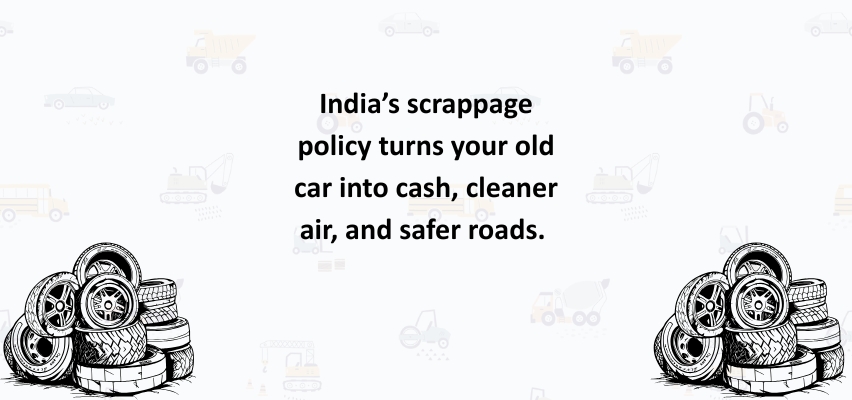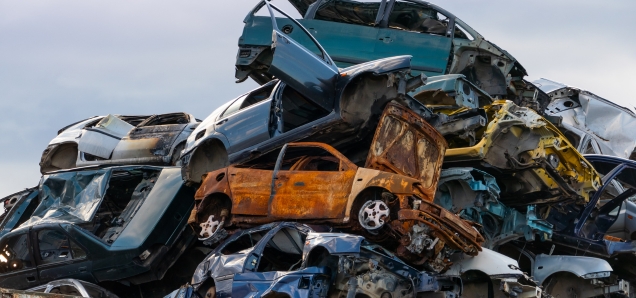Your Old Car’s Lease on Life: India’s Scrappage Policy Explained Simply
Did you know your old car could be worth more as scrap than as a running vehicle? Welcome to India’s Vehicle Scrappage Policy – a game-changer for car owners, our cities, and the environment. Let’s break it down in plain language!
1. What is This "Scrappage Policy" Anyway?
-
Think of it like a retirement plan for old, polluting vehicles.
-
If your car or bike is too old or unfit to drive safely, the government encourages you to scrap it responsibly.
-
In return, you get cash discounts and tax benefits on a new, cleaner vehicle 212.
2. Why now?
-
India has over 5 million private cars older than 20 years.
-
Old vehicles pollute 10–12 times more than new ones .
-
Accidents due to brake failures or breakdowns are common in ageing vehicles.
3. Is Your Vehicle Affected?
-
Check your car’s status: Visit the VAHAN portal (mparivahan.gov.in) with your registration number.
| Vehicle Type |
Age Limit |
What Happens? |
| Private Cars |
20+ years |
Mandatory fitness test. Pay higher fees to re-register |
| Commercial Vehicles |
15+ years |
Yearly fitness tests. |
| Government Vehicles |
15+ years |
Must be scrapped – no choice |
| Vintage Cars |
Any age |
Exempt! No scrapping required |
4. Why Scrap? Benefits You CAN’T Ignore
-
Replacing your old clunker isn’t just eco-friendly – it’s smart economics:
Discounts on New Cars:
-
Get 1.5–6% OFF ex-showroom price (e.g., ₹20,000 off a ₹10 lakh car) from brands like Tata, Maruti, Hyundai 13.
-
Luxury brands like Mercedes offer flat ₹25,000 discounts 13.
Tax Breaks:
-
25% OFF road tax for private cars.
-
15% OFF for commercial vehicles 12.
-
Zero Registration Fees: Save ₹1,000+ on new vehicle paperwork 8.
-
Scrap Value: Get 4–6% of your old car’s original price as cash from scrapyards 8.
-
Plus, you’ll save on fuel (new cars are 20–40% more efficient) and repairs (fewer breakdowns!) 2.
5. Beyond Savings: Greener Roads, Safer Journeys
-
This policy isn’t just about money – it’s about our future:
-
Cleaner Air: Phasing out 1 million old cars = Cutting 15–20% of transport pollution.
-
Boost for Electric Vehicles (EVs): New EV buyers get:
-
Green tax waivers
-
Subsidies up to ₹3,679 crore under the PM E-DRIVE scheme 14.
-
Job Creation: Scrapping centers need staff – 50,000+ new jobs expected 813.
6. How to Scrap Your Car in 4 Simple Steps
-
Use govt-approved centers like Maruti Suzuki’s MSRVs or Mahindra CERO 2.
-
Avoid shady dealers – only RVSFs (Registered Vehicle Scrapping Facilities) issue valid "Certificates of Destruction" 7.
-
Gather Documents:
Registration Certificate (RC)
Aadhaar/PAN card
Pollution Under Control (PUC) certificate 2
-
Deregister at RTO:
Submit the scrapping certificate to your local RTO.
Clear pending fines or loans first 8.
-
Buy New & Claim Benefits:
Show your scrapping certificate to the new car dealer for discounts + tax waivers .
Deadline Alert: Fitness tests for heavy vehicles start Oct 1, 2024. Other vehicles: June 1, 2025 .
7. Scrap vs. Keep: Which is Smarter?
-
Scrapping an ageing vehicle is often more economical and environmentally responsible than holding on to it.
| Situation |
Keep Your Car |
Scrap It! |
| Fitness Test |
Passes easily |
Fails |
| Costs |
High renewal fees + Green Tax |
Save on taxes + discounts |
| Sentimental Value |
Vintage/well-maintained |
High maintenance costs |
| Environment |
High pollution |
Zero emissions with new EV |
Example: Re-registering a 20-year-old car costs ₹5,000 + 15% green tax. Scrapping it saves this fee AND gets you ₹20k–₹50k in benefits.
The Road Ahead: A Win-Win for Everyone
India’s scrappage policy turns your old car into cash, cleaner air, and safer roads. With 84+ RVSFs already operational 14, retiring your ride is now hassle-free.
Final Tips:
Use your scrapping benefits to upgrade to an EV – enjoy extra subsidies and near-zero running costs.


